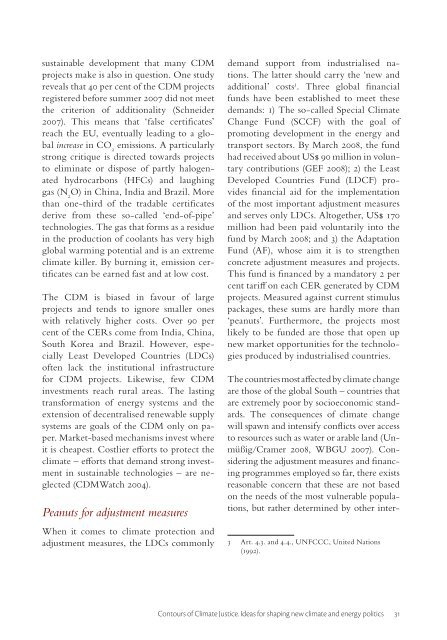Contours of Climate Justice - Dag Hammarskjöld Foundation
Contours of Climate Justice - Dag Hammarskjöld Foundation
Contours of Climate Justice - Dag Hammarskjöld Foundation
Create successful ePaper yourself
Turn your PDF publications into a flip-book with our unique Google optimized e-Paper software.
sustainable development that many CDM<br />
projects make is also in question. One study<br />
reveals that 40 per cent <strong>of</strong> the CDM projects<br />
registered before summer 2007 did not meet<br />
the criterion <strong>of</strong> additionality (Schneider<br />
2007). This means that ‘false certifi cates’<br />
reach the EU, eventually leading to a global<br />
increase in CO 2 emissions. A particularly<br />
strong critique is directed towards projects<br />
to eliminate or dispose <strong>of</strong> partly halogenated<br />
hydrocarbons (HFCs) and laughing<br />
gas (N 2 O) in China, India and Brazil. More<br />
than one-third <strong>of</strong> the tradable certifi cates<br />
derive from these so-called ‘end-<strong>of</strong>-pipe’<br />
technologies. The gas that forms as a residue<br />
in the production <strong>of</strong> coolants has very high<br />
global warming potential and is an extreme<br />
climate killer. By burning it, emission certifi<br />
cates can be earned fast and at low cost.<br />
The CDM is biased in favour <strong>of</strong> large<br />
projects and tends to ignore smaller ones<br />
with relatively higher costs. Over 90 per<br />
cent <strong>of</strong> the CERs come from India, China,<br />
South Korea and Brazil. However, especially<br />
Least Developed Countries (LDCs)<br />
<strong>of</strong>ten lack the institutional infrastructure<br />
for CDM projects. Likewise, few CDM<br />
investments reach rural areas. The lasting<br />
transformation <strong>of</strong> energy systems and the<br />
extension <strong>of</strong> decentralised renewable supply<br />
systems are goals <strong>of</strong> the CDM only on paper.<br />
Market-based mechanisms invest where<br />
it is cheapest. Costlier eff orts to protect the<br />
climate – eff orts that demand strong investment<br />
in sustainable technologies – are neglected<br />
(CDMWatch 2004).<br />
Peanuts for adjustment measures<br />
When it comes to climate protection and<br />
adjustment measures, the LDCs commonly<br />
demand support from industrialised nations.<br />
The latter should carry the ‘new and<br />
additional’ costs 3 . Three global fi nancial<br />
funds have been established to meet these<br />
demands: 1) The so-called Special <strong>Climate</strong><br />
Change Fund (SCCF) with the goal <strong>of</strong><br />
promoting development in the energy and<br />
transport sectors. By March 2008, the fund<br />
had received about US$ 90 million in voluntary<br />
contributions (GEF 2008); 2) the Least<br />
Developed Countries Fund (LDCF) provides<br />
fi nancial aid for the implementation<br />
<strong>of</strong> the most important adjustment measures<br />
and serves only LDCs. Altogether, US$ 170<br />
million had been paid voluntarily into the<br />
fund by March 2008; and 3) the Adaptation<br />
Fund (AF), whose aim it is to strengthen<br />
concrete adjustment measures and projects.<br />
This fund is fi nanced by a mandatory 2 per<br />
cent tariff on each CER generated by CDM<br />
projects. Measured against current stimulus<br />
packages, these sums are hardly more than<br />
‘peanuts’. Furthermore, the projects most<br />
likely to be funded are those that open up<br />
new market opportunities for the technologies<br />
produced by industrialised countries.<br />
The countries most aff ected by climate change<br />
are those <strong>of</strong> the global South – countries that<br />
are extremely poor by socioeconomic standards.<br />
The consequences <strong>of</strong> climate change<br />
will spawn and intensify confl icts over access<br />
to resources such as water or arable land (Unmüßig/Cramer<br />
2008, WBGU 2007). Considering<br />
the adjustment measures and fi nancing<br />
programmes employed so far, there exists<br />
reasonable concern that these are not based<br />
on the needs <strong>of</strong> the most vulnerable populations,<br />
but rather determined by other inter-<br />
3 Art. 4.3. and 4.4., UNFCCC, United Nations<br />
(1992).<br />
<strong>Contours</strong> <strong>of</strong> <strong>Climate</strong> <strong>Justice</strong>. Ideas for shaping new climate and energy politics 31
















